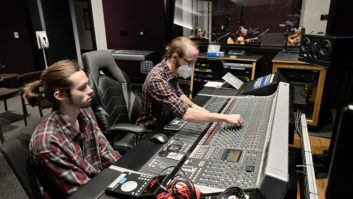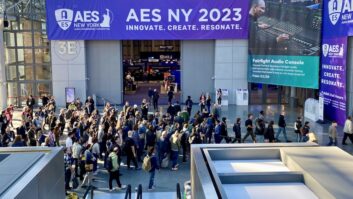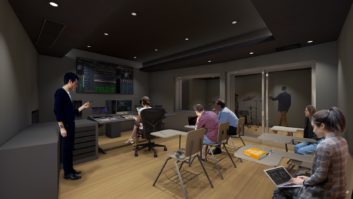Kennedy Space Center, Florida … There’s something magical about the lift-off a Space Shuttle. Whether you’ve seen one or a dozen such events, the sheer force required to propel the rocket / shuttle combination upward is fascinating. In an effort to produce a documentary in partnership with Nashville Public Television titled Zero Days Until Launch, Middle Tennessee State University (MTSU) assembled some of its top-tier graduate and undergraduate students to capture the launch of Space Shuttle Atlantis, STS-129, on November 16th, 2009. Armed with some of the finest production equipment available, the team recorded the event—with the audio portion being captured using two MA-100 condenser microphones from Mojave Audio.
Middle Tennessee State University offers the largest audio production and music business program of any school in the nation. With a qualified, knowledgeable faculty and staff, cutting-edge facilities, and a variety of real-world applications—such as the launch of Space Shuttle Atlantis—the University’s program is both unique and very highly regarded. For the recent Space Shuttle launch, graduate class MRAT 6340 Directed Production: Remote Teleproduction, was paired with an advanced undergraduate class from the MTSU Dept. of Electronic Media Communication called EMC 4940: Advanced Seminar in Electronic Media Production. Together, roughly 20 students, along with professors Dr. Mary Nichols and Mr. Daniel Pfeifer made the trek to the Kennedy Space Center (KSC). Adam Ellis, a MFA Candidate at MTSU, discussed the process of capturing the launch.
“We set the remote truck up in the media area at KSC, and the microphone position was near the famed countdown clock, about 3.4 miles from the launch pad,� explained Ellis. “On launch day, I was A1, along with A2 engineer Jeremy Dudman. Together, we were responsible for the recording of the launch as well as getting the various audio feeds provided by N.A.S.A, such as the air to ground communications and mission commentary. We used two Mojave MA-100’s with omni capsules as an A/B pair and fed their output into a Millennia HV-3D preamp. Using transformer-isolated splitters, we ‘bracketed’ the output of the microphones to the preamp. One stereo pair of inputs was recorded with lower gain settings than the other pair. This way, if the higher gained pair clipped, we still had a shot at capturing good quality audio on the other.�
“A space shuttle launch is a massive and dynamic event,� Ellis continued, “and if you don’t get it the first time, there’s no going back. By working in the manner that we did, we effectively had an insurance policy on a one shot deal. Research into the sounds produced by the shuttle, at a distance of about 3.5 miles, revealed that we could expect average SPL’s of roughly 80 db, a potential crest factor of nearly 50 db, and momentary / peek SPL’s of 125 db. The catch to all of this is that the majority of that energy was 60 Hz and below. These are conditions one can reasonably call extreme for any microphone, yet they fall well within the MA-100’s specification. This is precisely why we chose the MA-100’s.�
Ellis reports that the Space Shuttle project was a tremendous success that everyone involved benefitted immensely from the experience. He was particularly complimentary of the MA-100’s performance. “With the majority of the audio program being 60 Hz and below,� he said, “there was a tremendous amount of low frequency energy to capture. This is a region where the MA100 performs beautifully. Capturing that much low end, relative to itself, with a small diaphragm condenser microphone is exceptional.�
Daniel Pfeifer, Professor and Audio Internship Coordinator at MTSU’s Department of Recording Industry, was equally enthusiastic about the results. “The Mojave MA-100’s helped Adam effectively capture the very dynamic acoustic signature of a shuttle launch. Since we only had one shot to make a good recording, the choice and placement of microphones were considered to be ‘mission critical’ (to borrow a NASA term). We were pleased with the performance of the MA-100’s and feel they made a good choice for this application.�
To learn more about Middle Tennessee State University’s Department of Recording Industry, visit the University online at http://recordingindustry.mtsu.edu/.
About Mojave Audio
Located in Burbank, California, Mojave Audio is a manufacturer of quality microphones for the recording professional. Additional information on the MA-100 and all Mojave Audio products can be found online at www.mojaveaudio.com.
###
Photo info: Image of the liftoff of Space Shuttle Atlantis, STS-129. Photo credit: NASA







